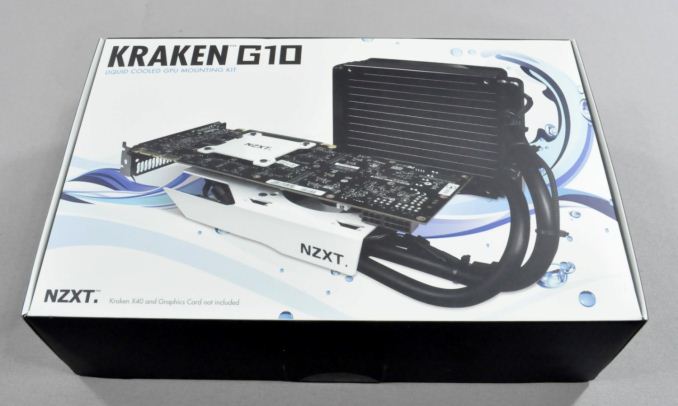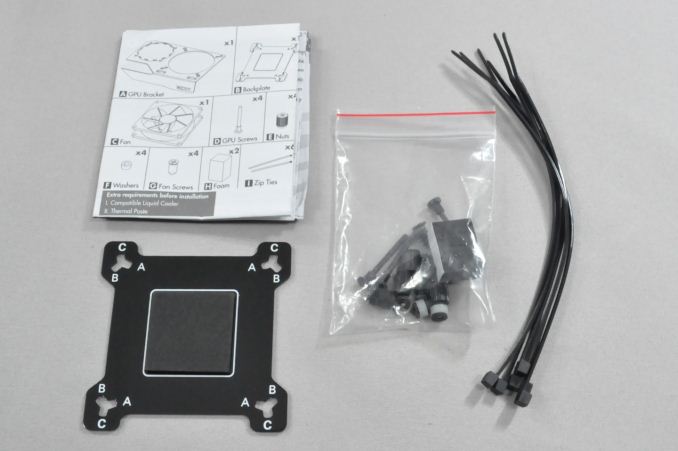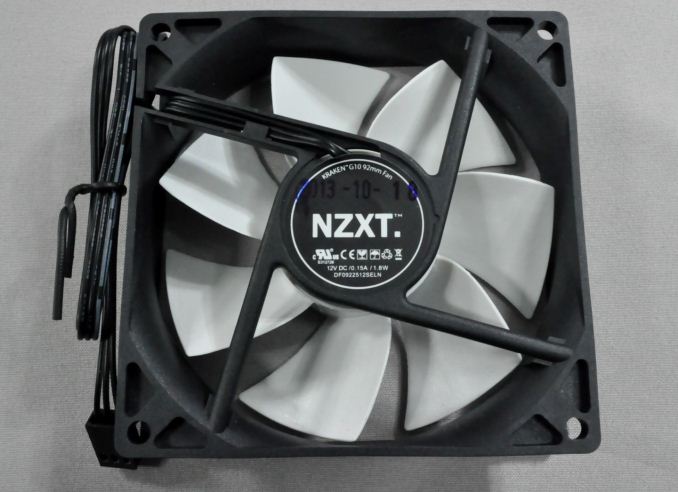NZXT Kraken G10 Review: Liquid Cooling for Your GPU
by E. Fylladitakis on March 11, 2014 1:15 AM EST- Posted in
- Cases/Cooling/PSUs
- NZXT
- Water Cooling
- Kraken
- G10

Introduction
Liquid-cooling is nothing new in the world of computers; enthusiasts first started creating custom water cooling setups back in the 80486 era, and even prior to that some mainframes used liquid-cooling. Due to their cost and complexity however, such cooling solutions often do not appeal to a large portion of users. With the advent of of closed loop, ready-to-run liquid-cooling kits from Asetek and CoolIT a few years back, however, liquid-cooling is now significantly less costly and complex. Today, the cooling solutions of both these two OEMs are being marketed by several brands and are becoming increasingly popular among all classes of users.
Despite the low cost and ease of installation however, these closed loop systems entirely lack the one thing that a custom liquid-cooling solution has: versatility. All of the closed loop liquid-cooling kits currently available in the market are designed be installed on a single CPU, without the possibility of any expansion, whereas custom setups could potentially cool all of the critical components in a system. Until recently, those who purchased any closed loop liquid-cooling kit were limited to cooling their CPU only, leaving their high-end graphics cards running on air. NZXT came up with a very simple and effective solution to this problem: a metallic bracket called the Kraken G10 that allows the installation of any Asetek-based liquid-cooling kit on most modern graphics cards. The compatibility list, as provided by NZXT, is as follows:
| GPU Compatibility |
Nvidia: GTX 780 Ti, 780, 770, 760, Titan, 680, 670, 660Ti, 660, 580, 570, 560Ti, 560, 560SE AMD: R9 290X, 290, 280X*, 280*, 270X, 270 HD7970*, 7950*, 7870, 7850, 6970, 6950, 6870, 6850, 6790, 6770, 5870, 5850, 5830 The compatibility list is based on AMD's Radeon and NVIDIA's GeForce reference board layouts, screw spacing, and die height only. Please check the height restriction before purchase. * Some variations in AMD die height may require the use of a shim. |
| Liquid-cooling kit compatibility |
NZXT: Kraken X60, Kraken X40 Corsair: H110, H90, H75, H55 , H50 Antec: KUHLER H2O 920V4, KUHLER H2O 620V4, KUHLER H2O 920, KUHLER H2O 620 Thermaltake: Water 3.0 Extreme, Water 3.0 Pro, Water 3.0 Performer, Water 2.0 Extreme, Water 2.0 Pro, Water 2.0 Performer Zalman: LQ-320, LQ-315, LQ-310 |
Packaging and bundled items
NZXT ships the Kraken G10 in a well-designed cardboard box, displaying their Kraken X40 liquid-cooler installed on a graphics card with the help of the bracket. Inside the box we find a leaflet with installation instructions, the hardware required for the installation of the bracket, and a few cable ties.
NZXT also supplies a 92mm fan, which can be installed on the Kraken G10 in order to cool the VRM and RAM chips of the graphics card. Such parts are inherently cooled by the stock cooler of the card, but as that will be removed and the liquid block only cools GPU core, the fan is a useful addition. The white-bladed fan comes from Martech and is a sleeve bearing, 2000RPM model.













61 Comments
View All Comments
kyuu - Wednesday, March 12, 2014 - link
Awesome, thanks for the info.Jioker - Wednesday, July 23, 2014 - link
Hi mate, I was wondering if you could give me/us a more in depth "installation guide" of the heatsinks on the VRMs (as I got a bit confused)? It would very helpful! :DWhatchagot - Tuesday, March 11, 2014 - link
I thought the issue was that GPU liquid coolers need to cool VRM too. While they seem to perform well they don't cool the whole unit properly. Please correct me if I'm wrong.E.Fyll - Tuesday, March 11, 2014 - link
That is partially true. You see, it is not unlikely that the VRM of more powerful cards may require extra cooling, especially if the removal of the stock cooler means that the VRM will remain entirely without cooling. However, with the EVGA GTX 770 that I used for the review, the temperature increase of the VRM section was marginal, at best. It would appear that it depends on several factors, such as the design and the power of the card. I only had one card to test it on so I apologize for the lack of extensive data on the matter.Whatchagot - Tuesday, March 11, 2014 - link
Thanks for sharing the experience. Many people are interested in how to cool the GPU better and quieter.Any noise measurements or perceived improvements in noise?
E.Fyll - Wednesday, March 12, 2014 - link
Well, that would depend on the AIO kit used, the speed of the fans, etc. I suggest that you read our roundup review of AIO kits, that should help you select the most suitable Asetek-based kit according to your needs.Popskalius - Tuesday, March 11, 2014 - link
why not just have longer hoses?Yungbenny911 - Tuesday, March 11, 2014 - link
It depends on the type of closed loop cooler you are using. I personally prefer shorter hoses to reduce the time it takes the coolant to go back through the radiator, and back to the GPU.WithoutWeakness - Tuesday, March 11, 2014 - link
I hate to say but the length of the hoses and their effect on the time it takes coolant to flow from the block to the radiator has next to no impact on the cooling potential of a water loop. The whole loop is full of liquid and the block always has water flowing through it. The length of hoses does not affect the flow rate of a water loop - the pump does. You could use 1 foot hoses or 10 foot hoses and the water would flow at the same rate (gallons/minute or liters/minute) on a given pump.mpdugas - Tuesday, March 11, 2014 - link
However, the longer hoses hold more fluid; that is a cooling benefit in-and-of itself.One thing I noticed about LC; the latent heat in the liquid keeps the CPU/GPU warmer, longer, than a good AC kit.
The thermal shock is less, however, as the CPU/GPU warms more slowly and cools more slowly, as well.